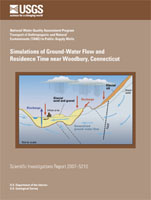Water withdrawn for public use from glacial stratified deposits in Woodbury, Connecticut, is a mixture of water from different source areas, each having a characteristic water-quality signature. The physical processes leading to this mixture were explored using a numerical model to simulate steady-state ground-water source areas and residence times for a public water-supply well (PSW-1) in Woodbury. Upland areas contribute water to the well that is primarily from undeveloped and agricultural land. Valley bottoms contribute water to the well that is primarily from developed land. From 1985 to 2002, 6 percent of the contributing recharge area to the well changed from agricultural and undeveloped to developed land. The pattern of recharge areas and land use causes stratification of ground water by residence time and by characteristic water quality, which is related to land use. As land use changes with time, the water-quality signature of developed land moves deeper into the aquifer. Predicted nitrate concentrations decreased from 1985 to 1995 because of the conversion from agricultural land to developed land, but then began to increase after 1995 because of the conversion of undeveloped land to developed land. Total dissolved solids concentrations, on the other hand, increased from 1985 to 2002 because agriculture is associated with lower total dissolved solids concentrations than is developed land.
About 40 percent of the water withdrawn from PSW-1 originated as upland recharge before flowing through glacial deposits in the valley. About 44 percent of the water originated as recharge in either fluvial deposits (mean residence time 7 years) or deltaic deposits (mean residence time 4 years). About 16 percent of the water originated as recharge through storm drains with ground-water discharge (often known as 'dry wells'). The residence time for water that originated as recharge in dry wells is 2 to 4 years, and the mean residence time is 3 years. Dry wells are a fast pathway for water to enter the aquifer and provide a significant amount of water to PSW-1; therefore, PSW-1 is more susceptible to contamination in runoff from the commercial area, which enters the dry wells, than to recharge elsewhere in the area. Water withdrawn from a well is a mixture of waters with different residence times, and a single residence time does not fully characterize the susceptibility of the well to recent contamination. The mean simulated flow-weighted residence time in PSW-1 is 6 years, which compares reasonably well with the apparent residence time measured using tritium/helium data of 6 and 7 years (samples for age dating were collected twice from this well). There are at least two modes to the distribution of ages, one mode with residence times less than 5 years and one mode with residence times greater than 5 years. About 34 percent of the ground-water in PSW-1 is younger than 5 years and 56 percent of the water is from 5 to 9 years.
The estimated nitrate loading rate from a single-family septic system is 18 grams per day. If each household in the contributing recharge area contributes nitrate at that loading rate to the well PSW-1, each additional septic system in the contributing recharge area is responsible for a 0.045-milligram-per-liter increase in nitrate at PSW-1 at the current pumping rate.
Uncertainty in the predicted contributing recharge area can be propagated through the analysis using a Monte Carlo technique. There is a greater degree of certainty in the delineation of the recharge area near the well, and as one moves from the well toward the recharge areas, the uncertainty in the model increases. The area that possibly contributes water to the well using the Monte Carlo model is much larger than the recharge area delineated using the optimal parameter estimates. Within the probabilistic recharge area, the number of septic systems could be twice the number initially estimated.


